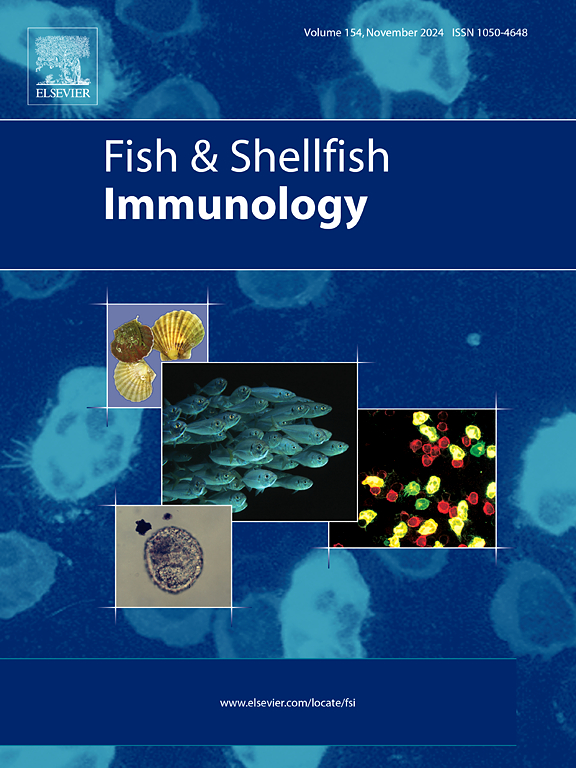凡纳滨对虾纤维蛋白原相关蛋白的基因组分析及表达分析。
IF 4.1
2区 农林科学
Q1 FISHERIES
引用次数: 0
摘要
含有纤维蛋白原相关结构域(FReD)的蛋白是一个进化上保守的免疫基因家族,其特征是c端纤维蛋白原(FBG)和多种n端结构域。为了了解该家族在甲壳类动物中的复杂性,我们对凡纳滨对虾(Litopenaeus vannamei)进行了基因组筛选,并鉴定了43个全长FReDs编码基因。结构分类分析表明,这些推测的fred可分为6种类型,包括2种已报道的类型(LvFReDI和II)和4种新类型(LvFReDIII-VI)。序列和系统发育分析表明,FBG结构域高度保守,系统发育集群与基因型密切相关。利用南美扁豆发育阶段、成虫组织和病原菌感染组织的转录组分析了LvFReD基因的时空表达模式。大多数LvFReDs在膜期幼虫开始表达,并在细菌或病毒攻击后表现出组织特异性表达模式和免疫应答性转录。进一步的时间序列表达分析表明,具有额外卷曲区域的LvFReDII基因比LvFReDI基因对病原菌更敏感。本研究提供了虾中FReD基因的完整基因序列资源和表达谱,为阐明这些基因在甲壳类动物中的多样性和功能提供了新的思路。本文章由计算机程序翻译,如有差异,请以英文原文为准。
Genomic insights into fibrinogen-related proteins and expression analysis in the Pacific white shrimp, Litopenaeus vannamei
Fibrinogen-related domain (FReD) containing proteins are an evolutionarily conserved immune gene family characterized by the C-terminal fibrinogen (FBG) and diverse N-terminal domains. To understand the complexity of this family in crustaceans, we performed genome screening and identified 43 full-length FReDs encoding genes in Litopenaeus vannamei. Structural classification analysis revealed these putative FReDs could be divided into six types, including two reported types (LvFReDI and II) and four new types (LvFReDIII-VI). Sequence and phylogenetic analysis showed that FBG domains were highly conserved throughout and phylogeny clusters correlated strongly with gene type. We analyzed the temporal and spatial expression patterns of LvFReD genes based on the transcriptomes of developmental stages, adult tissues or pathogen infected tissues of L. vannamei. Most LvFReDs were expressed from larval in membrane stage, and exhibited tissue-specific expression patterns and immune-responsive transcription after challenge with bacteria or virus. Further time-course expression analysis suggested that LvFReDII genes with additional coiled-coil region were more sensitive to pathogens than LvFReDI genes. Our findings provided comprehensive gene sequence resources and expression profiles of FReD genes in shrimp, which give insights into clarifying the diversity and function of these genes in crustaceans.
求助全文
通过发布文献求助,成功后即可免费获取论文全文。
去求助
来源期刊

Fish & shellfish immunology
农林科学-海洋与淡水生物学
CiteScore
7.50
自引率
19.10%
发文量
750
审稿时长
68 days
期刊介绍:
Fish and Shellfish Immunology rapidly publishes high-quality, peer-refereed contributions in the expanding fields of fish and shellfish immunology. It presents studies on the basic mechanisms of both the specific and non-specific defense systems, the cells, tissues, and humoral factors involved, their dependence on environmental and intrinsic factors, response to pathogens, response to vaccination, and applied studies on the development of specific vaccines for use in the aquaculture industry.
 求助内容:
求助内容: 应助结果提醒方式:
应助结果提醒方式:


